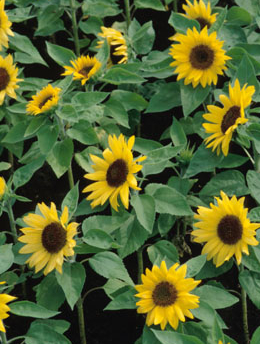The sunflower, scientifically known as Helianthus annuus, is a flower native to America. The flower's name has been derived from its shape and color, which looks like the sun. The following section gives more information about the sunflower plant and how to care for it.

The sunflower has bright, yellow-colored petals, and is a sun-loving, flowering plant, which truly justifies its name. According to taxonomy, sunflowers belong to the
Asteraceae family, which includes garden plants like aster, daisy, and gerbera. Its genus name is
Helianthus and species name varies according to the cultivar. Sunflower plants are annual or perennial, depending on their species.
Growing Sunflowers
Sunflower plants are prized not only for their aesthetic value, but also because they bear edible seeds which serve as a vegetable oil source. A single bloom can yield up to 2000 seeds. It is very easy to grow this plant―whether it is for ornamental purposes or for seeds―and one only requires basic gardening skills. You can implement the following planting tips.
Select the Sunflower Variety
The most important step is selecting the correct variety of the flower for home plantation. You can research on sunflower cultivars with respect to their care and maintenance levels. Take note of the flower size, plant height, and resistance to diseases. Popular sunflower varieties are Teddy Bear Dwarf (2 feet), Giant Gray Stripe (15 feet), Italian White (6 feet), and Orange Sun Bright (6 feet).
Ideal Planting Time
The best time for growing this plant is during spring. Nevertheless, the preferable growing period varies depending on whether you are sowing the seeds or planting the seedlings directly. If you are interested in planting the seeds, consider planting them indoors before the arrival of frost. By the time they sprout and develop, the environmental conditions will warm up.
Sow the Seeds
Although some sunflower plant varieties perform well by direct sowing in garden soil, it is always better to avoid that risk. You can prepare a seedbed instead and sow the seeds indoors, or in pots filled with peat. If you are interested in outdoor sowing, prepare the soil and lightly sprinkle the seeds. Cover the area with a screen to conserve soil moisture and avoid feeding by birds.
Transplant the Seedlings
Transplanting the seedlings is best done after the frost is over. Even a mild frost can cause damage to young plants. Careful handling of these seedlings is recommended as they are fragile and prone to injury. For transplantation, loosen the garden soil with a spade and add compost to increase its fertility. Make planting holes large enough to hold the root system of the seedlings. Place the plants gently in the hole, maintaining a space of about 10 inches between two plants, and cover the roots with soil.
Sunflower Plant Care
Water the sunflower seedlings generously in the first few weeks after transplantation. For optimal growth, the plant requires sunlight in the morning and shade in the afternoon. For fertilization, you can purchase a fertilizer with nitrogen, phosphorus, and potassium in the ratio 10:15:10. Add an appropriate amount of this formulation near the plant, about 2-3 inches away from the stem. Following this, water the soil to promote assimilation of nutrients. Taller varieties require staking to support the stem and protect them from strong winds.
Harvesting the Plants
If you are growing these plants in spring, they will bloom by summer. Harvesting the seeds should be done after the flowers die, or when a majority of the petals have dropped. You can check the fullness of the seeds by opening some of them. If the inside seeds touch the outer coat, then they are ready for harvesting. Cut the flower head with a sharp knife, making sure that you retain a few inches of the green stalk. Allow the flower heads to dry properly before extracting the seeds.
Applying the above tips will help your sunflowers to grow fast and well. These plants do not have any major disease problems, but check for unwanted feeding by squirrels and other invaders.






 The sunflower has bright, yellow-colored petals, and is a sun-loving, flowering plant, which truly justifies its name. According to taxonomy, sunflowers belong to the Asteraceae family, which includes garden plants like aster, daisy, and gerbera. Its genus name is Helianthus and species name varies according to the cultivar. Sunflower plants are annual or perennial, depending on their species.
The sunflower has bright, yellow-colored petals, and is a sun-loving, flowering plant, which truly justifies its name. According to taxonomy, sunflowers belong to the Asteraceae family, which includes garden plants like aster, daisy, and gerbera. Its genus name is Helianthus and species name varies according to the cultivar. Sunflower plants are annual or perennial, depending on their species.